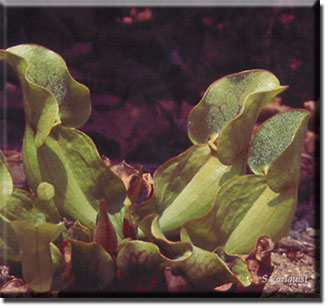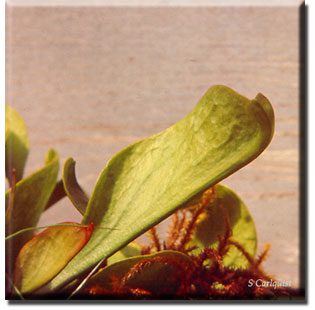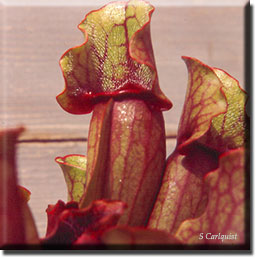Sarracenia purpureaCarnivorous Plants / Insectivorous Plants
Sarracenia purpurea, the purple pitcher plant--or the northern pitcher plant--ranges from Virginia to Newfoundland, and inland to the Great Lakes region of the northern United States and extensive areas of Canada. It occurs in boggy patches, often in small pools. Although the plants in this photograph are green, plants that are red to deep purple may be found--that depends on the location. Notice the crescent-like wing on the side of the pitchers facing the center of the plant. This wing is like the edges of the leaf flattened against each other.
This picture of a young pitcher leaf of Sarracenia purpurea shows that the tubular part of the leaf is narrow and the lid of the pitcher is curled over, so that the tube of the pitcher leaf is not yet accessible. The wing of the pitcher, however, is fully developed, and most of what you see in this young leaf is, in fact, the wing of the leaf. A mature pitcher leaf of Sarracenia is usually greenish to reddish with darker-colored veins. When the pitcher leaves are mature, the wing is less conspicuous because the lid has expanded and the tube of the leaf has widened out considerably. The reddish colors and markings are visible to and attractive to some insects, and contrast with the predominantly green colors of the vegetation where pitcher plants grow. Consequently, insects can se pitcher plants at a distance and are attracted to them.
The lid of the pitcher of Sarracenia purpurea is frilly and roughly triangular in shape, a shape which distinguishes this species easily (along with the wide, squat shape of the pitchers) from other species of Sarracenia. The lid has been especially illuminated here to show the stiff downwardly pointing hairs, which tend to make an insect that has landed on the lid walk downward into the pitcher. A section down the length of a pitcher of Sarracenia purpurea reveals that the stiff downwardly-pointing hairs extend most of the way down to the base of the tube. So a crawling insect is guided down to a pool o0f liquid (not visible in this section) in the bottom of the pitcher. Notice that hairs are not present at the very bottom portion of the pitcher, which is where the pool of liquid would be. The flower of Sarracenia purpurea, like flowers of all of the pitcher plants, is curved over when it's mature. The sepals are red-purple and pointed, the petals are red and rounded. An approaching insect would be guided into the flower between two of the sepals--it would land on a petal and climb into the flower. 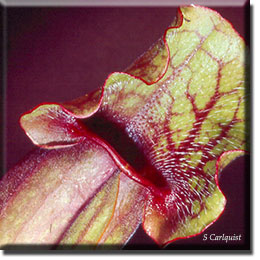 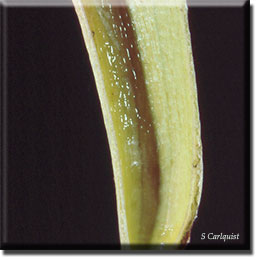 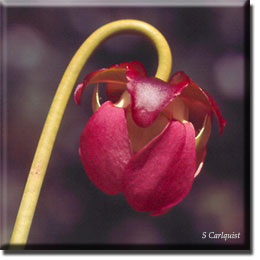 img src="https://botany.org/Carnivorous_Plants/images/Sarracenia_purpurea-SC-7.jpg" alt="Carnivorous plant - Sarracenia purpurea" align="right" /> We can't see exactly what an insect sees as it goes into a Sarracenia purpurea flower, but we can see the pathway it takes by cutting off one edge of the flower. We see the big green stigma, looking like a scalloped umbrella. Inside those scallops or curves of the stigma, we see the yellow stamens, which contain the pollen. So on its way into a flower, an insect is likely to get dusted with pollen, if the stamens happen to be shedding pollen on a particular day.
Here's a section of the flower with the edge of the umbrella-like stigma cut away. A visiting insect at this point will walk along the green umbrella-like structure, and the sticky surfaces (the upper surface, like the "inside" of an umbrella opened out) will pick up pollen. Perhaps pollen from a flower on another plant of Sarracenia purpurea. So cross-pollination will occur. Seeds of Sarracenia purpurea, greatly magnified. There are tiny knobs on the surface of the seeds. These may aid in dispersing the seeds to new localities. The bogs where Sarracenia purpurea are like islands, each separated from another bog by broad non-boggy areas. So the seeds must be adapted for dispersal from one boggy area to another.  |
